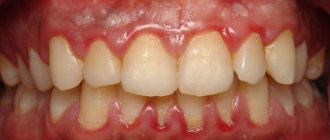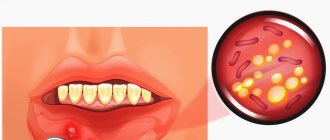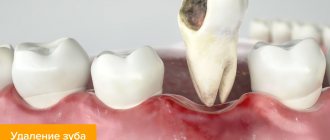Inflammatory gum disease in adults and children is called gingivitis. It is most often observed in children a few months from birth to 13 years of age, which is explained by the characteristics of the child’s body and poor oral hygiene.
According to statistics, in a child from 2 to 4 years old, gum inflammation occurs in 2% of cases, and by the age of 13, the proportion of this disease in children reaches 80%. Gingivitis cured in time does not become chronic, but if left untreated it can cause the development of periodontitis.
Causes of gingivitis in children
There are many causes for childhood gingivitis. The gums become inflamed due to the functional immaturity of their tissues. In babies under one year of age, the cause of the disease is often teething, when the gums become red and sore. Sometimes inflammation is caused by an allergic reaction to food.
In adolescents, the disease may manifest itself due to the eruption of a permanent tooth. When soreness during brushing does not allow this procedure to be performed efficiently, microbes multiply and gum inflammation develops.
The most common factors that provoke the development of gingivitis in older children are:
Action of microbes
In 90% of cases, the disease appears in a child due to insufficient oral hygiene, as a result of which microorganisms multiply intensively, plaque and tartar form, and stomatitis develops.
Mechanical injury
The integrity of the mucous cavity can be compromised by teething, cuts, scratches, burns, biting, improper brushing of teeth, and eating solid foods.
Foci of infection in the oral cavity
If children have carious teeth, there is a chance that they will develop infectious gingivitis, which affects the gums. Therefore, teeth that require treatment must be treated as soon as possible.
Excessive loads on the dental system
Other causes of gum damage in children may include:
- presence of malocclusion;
- poor nutrition with a lack of vegetables and fruits;
- uneven load on the dental system due to bad habits;
- defects of the oral cavity (short frenulum of the tongue, lips);
- the presence of caries, various infections;
- thermal burn from hot food;
- wearing braces.
Possible complications
The initial stage of the disease is easy to treat.
Most often, the initial stages of diseases accompanied by the appearance of white plaque on the gums proceed unnoticed. That is why there is a problem of early diagnosis of such a disease, which can sometimes be very serious.
In an advanced stage, this symptom causes severe pain in the child, and then even the most inattentive parent will notice the problem. But treating the disease at this stage is much more difficult and longer.
In addition, in the absence of timely and correct treatment, various complications may arise:
- dysbacteriosis;
- problems with the gastrointestinal tract;
- damage to internal organs;
- transition of the disease to a chronic form;
- diseases of ENT organs;
- development of sepsis, etc.
Such complications can arise not only due to lack of treatment due to late diagnosis, but also during attempts at self-medication, when parents may mistakenly believe that they are able to cope with the disease on their own, without the help of a doctor. But in the end, this only makes the situation worse.
Symptoms
Gingivitis has a main symptom by which it is easily identified - inflammation affecting the child’s gums. The process begins with a slight redness that quickly gains strength. This signal often goes unnoticed by parents, and children go to the dentist with an active inflammatory process, bright red swollen gums, burning, and pain. These signs indicate that the disease has entered an acute phase.
Children suffer most from the catarrhal form of this disease, which can be chronic or acute. In the first case, the symptoms are not pronounced, pain occurs only when brushing, there is slight swelling, redness, and cyanosis of the gums.
A sign of an acute form of the disease is intoxication of the child’s body. It manifests itself as headache, nausea, lethargy, and fever.
The most complex type of disease, ulcerative gingivitis, manifests itself as follows:
- the inflammatory process progresses;
- their structure changes;
- there is an unpleasant odor from the mouth;
- lymph nodes in the neck enlarge;
- saliva is produced profusely;
- the skin turns pale.
If these signs are left unattended, an ulcerative-necrotic form of the disease may occur, when necrotic areas with a gray-green coating and a putrid odor appear on the gums, saliva becomes viscous, body temperature rises and the general condition significantly worsens.. All this indicates severe intoxication in organism.
During puberty in a teenager or if he has problems with hormones, hypertrophic gingivitis occurs. It occurs due to improper orthodontic treatment of dental anomalies. The inflammatory process is accompanied by increased growth of gingival tissue, which leads to partial closure of dental crowns. This form of the disease is usually localized. One or two gums are affected, sometimes the affected area expands. The most common location is the lower anterior incisors and canines.
Atrophic gingivitis does not have a pronounced inflammatory process and occurs without pain, although over time it can be complicated by periodontal disease.
What does thrush look like in a child?
Any part of the oropharynx can be affected: tongue, lips, corners of the mouth, gums, mucous membranes of the cheeks, palate, pharynx, tonsils. White grains (spot coating) appear, reminiscent of curdled milk, or a film (solid coating) of a cheesy appearance. These elements are easily removed by scraping with a spatula, revealing a bright red base, sometimes with a bleeding surface. As a rule, the course of the infection is painless and has only local manifestations. General health is not affected.
Diagnostic methods
The diagnosis is made by a doctor based on the results of studying the medical history and life of the child in combination with a dental examination. The patient’s complaints, the presence of somatic diseases, and whether he is taking medications that may cause the development of gingivitis are clarified.
Then the doctor conducts an external examination, paying attention to maxillofacial anomalies, the condition of the teeth and gums, and makes a diagnosis. The dentist does not require the help of other specialists, since the disease clearly manifests itself externally and does not require instrumental examination.
Child nutrition
Simple carbohydrates are the main nutrient medium for fungal growth. Therefore, sweets, sugar, cookies, etc. must be excluded from the patient’s diet. Breastfeeding certainly continues.
If the child is bottle-fed or mixed-fed, then preference should be given to formulas containing probiotic microorganisms, which have the largest evidence base for their effectiveness. These are LGG and BB-12 from Chr. Hansen. It has been proven that LGG and BB-12 inhibit the growth of opportunistic microorganisms and fungi, protect against the development of caries and infections, and effectively prevent atopic eczema. Nutrilak Premium Comfort is enriched with LGG probiotic.
Treatment
Treatment for childhood gingivitis is practically no different from how adults are treated. Only medications used for them are softer and more gentle. Treatment begins with professional cleaning of hard deposits and plaque of tooth enamel - mechanical or ultrasonic.
If caries is detected during the examination, then therapeutic treatment is carried out. Gingivitis is then treated with medications with antiseptic and anti-inflammatory properties. Measures are taken to eliminate detected pathologies (bite, frenulum, etc. are corrected).
Ointments and gels are considered effective for children under 4 years of age. For example, Cholisal ointment has analgesic and anti-inflammatory properties, which makes it possible to prescribe it to alleviate the patient’s condition, especially when baby or permanent teeth are cutting. Ointments and gels are applied directly to the inflamed area.
Antibiotics in tablets or in the form of injections are prescribed to children in difficult cases (the presence of infections of bacterial origin in the body). At elevated temperatures, rinses, drinking plenty of fluids, antioxidants, antipyretic drugs for children, and taking vitamins are prescribed.
Prevention measures should include regular visits to the pediatric dentist, training in oral care rules, and parental monitoring of the development of hygiene skills.
Prevention
To prevent oral diseases, regular examinations by a doctor are necessary.
It is important to understand that the fragile body of a newborn child is especially vulnerable. Therefore, you need to make enough efforts to prevent the occurrence of diseases, because then you will not have to deal with their treatment.
Oral health care includes, first of all, regular examinations of the baby's mouth for the presence of any formations, be it stains or plaque. If after eating a white coating appears on the child’s gums, then you need to try to gently clean it off with special means.
If you suspect the development of any disease, you should show the child to a doctor who will conduct an examination and establish an accurate diagnosis. After which he will be able to select the appropriate and most effective treatment.
How to prevent gum disease
For the reasons listed above, we recommend that you:
- Closely monitor how thoroughly and correctly your child brushes his teeth;
- Use a special fingertip to massage the baby’s gums during teething;
- Explain to your child how important it is to actively chew food on both sides;
- Contribute to timely correction of bite and solution of other problems;
- Monitor the temperature of your baby's food and drink and ensure that he does not have the opportunity to injure the delicate gum tissue.
Modern pediatric dentistry believes that minimizing the unpleasant consequences of developing a serious disease by strengthening preventive measures is the easiest way to protect your child from diseases of the gums and other periodontal tissues.
Calcium deficiency
In the first months of life, a child receives all vitamins and microelements (with the exception of vitamin D) only through food. If the baby is breastfed, the mother needs to monitor her diet: of course, first of all, this means limiting the diet to exclusively hypoallergenic and non-harmful foods - not fatty, fried, salty. At the same time, it is necessary to try to diversify the diet as much as possible so that as many vitamins and minerals as possible are transferred to the baby along with food. In particular, calcium.
Calcium is found in dairy products (especially cottage cheese, hard cheese), sesame seeds, dried apricots, sunflower seeds, and apples. Particular emphasis should be placed on these products - after all, calcium is one of the main “building materials” for bones.
If the baby is formula-fed, it is necessary to reconsider the diet and choose a different formula - additionally enriched with this macronutrient.
Vulnerability zone
Let's look at gum disease in children. Your child's healthy gums are delicate and very vulnerable tissue of a pale pink color. Unlike adult gums, they can be easily injured, but they are capable of rapid regeneration. Another peculiarity of children's gums is that they often reflect the general condition of the body, being a litmus test for systemic diseases.
The most common diseases of the gums and periodontal tissues: gingivitis is an inflammation of the gums that occurs as a result of the adverse effects of local and general factors, occurring in 80% of children; gum atrophy, which develops in more than half of the child population; various types of childhood stomatitis, which most often occurs in infants and preschoolers; Periodontitis is a disease in which all periodontal tissues become inflamed and affects up to 5% of young patients. Periodontal disease (dystrophic changes in periodontal tissue) and other pathologies practically do not occur in childhood.











